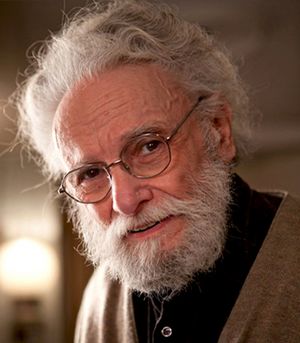Arthur Polonsky facts for kids
Arthur Polonsky (June 6, 1925 – April 4, 2019) was an American artist. He was a painter and a draughtsman, which means he was skilled at drawing. He also taught art.
Polonsky was known for his paintings and drawings that explored ideas like light, water, and flying. His art often hinted at myths, fantasy, music, or stories from the Bible. He was inspired by poets like Arthur Rimbaud and Rainer Maria Rilke. Another artist, Barbara Swan Fink, said his work always showed a lively conversation between color, texture, and the subject. His drawings were especially exciting. They captured a strong feeling and showed a bold use of lines. His portraits not only looked like the person but also showed a mood.
Polonsky was an important part of a group of artists called Boston Expressionism. This art style focused on showing emotions and ideas rather than just realistic images. He was involved with two main groups of artists in Boston. One group was connected to the School of the Museum of Fine Arts at Tufts, where Polonsky studied and later taught. The other group was linked to the Boris Mirski Gallery, where he showed his art.
In the late 1940s, Polonsky and other artists like Karl Zerbe and Hyman Bloom started meeting. They were worried that major museums in Boston were not showing enough art by modern artists. These meetings led to more action. They helped create the New England Chapter of Artists Equity. This group worked to protect artists' rights. They also helped start the Boston Arts Festival. This festival was a place where anyone could see fine art in the middle of Boston's Boston Public Garden. These efforts helped artists in New England connect and share ideas. This led to a unique style of Expressionism in the area.
Contents
Art Shows and Collections
Solo Exhibitions
Arthur Polonsky had many art shows where only his work was displayed. Here are some of the places where he had solo exhibitions:
- Boris Mirski Gallery, 1950, 1954, 1956, 1964
- Boston Center for Arts, 1983
- Boston Public Library, 1969, 1990, 1993, 1996, 1999
- Danforth Art, 2008
- Durlacher Gallery, NYC, 1965
- Fitchburg Art Museum, 1990
- Kantar Fine Arts, Newton, MA, 2002
- Metropolitan Museum of Art, NYC, 1950
- Mickelson Gallery, Washington, DC 1966, 1974
- St. Botolph Club Gallery, Boston, 2004–2005
- Starr Gallery, Boston, 1987
Public Collections
Polonsky's art is part of many public collections. This means his work is owned by museums and other public places for everyone to see. Some of these places include:
- Addison Gallery of American Art
- Brockton Art Museum, Brockton, MA
- Danforth Art
- DeCordova Museum and Sculpture Park
- Fogg Museum
- High Museum Art
- Honolulu Academy Arts
- Boston Public Library
- The Library of Congress
- Museum of Fine Arts, Boston
- Rose Art Museum
- Stedelijk Museum
- The New York Public Library
- Walker Art Center
- The White House
- Zimmerli Museum
Awards and Groups
Arthur Polonsky received several awards and was a member of important art groups:
- He won the Louis Comfort Tiffany award for painting in 1951.
- He won 1st prize at the Boston Arts Festival in 1954.
- He received a European Traveling Fellowship from the School of the Museum of Fine Arts (1948–1950).
- He was a member of the American Association of University Professors.
- He was a member of the Artists Equity Association, Inc.
Working for Artists
Early Meetings
After returning from Europe in the late 1940s, Polonsky started going to meetings. These meetings were to discuss concerns about the Institute of Contemporary Art, Boston in Boston. Artists like Bloom and Zerbe were worried the Institute might not support the kind of modern art they believed in. These meetings helped start the New England Chapter for Artist's Equity. This group worked to support artists' rights.
Boston Arts Festival
The artists who were part of these meetings also helped organize the Boston Arts Festival. These festivals, held in the 1950s and 1960s, showed fine art in tents in the Public Garden. They also had free performances in nearby Boston Common. This was a new and exciting way to show art in New England.
Polonsky said it felt like a "good, exuberant, democratic, freeing kind of idea." He felt that artists and the public really enjoyed these festivals. Many important people, including poets like Robert Frost, took the festival seriously. It was a big event each year with art shows and even opera performances.
Teaching Career
In 1947, Polonsky was a teaching assistant to artist Ben Shahn. This was at the Museum School’s Tanglewood Program. After he graduated, he traveled to France with a special fellowship.
From 1950 to 1960, he taught painting at the Boston Museum School. In 1954, he became an assistant professor at Brandeis University in the Fine Arts Department. He stayed there until 1965. From 1965 to 1990, Polonsky was an associate professor at Boston University, College of Fine Arts. He later became a professor emeritus, which means he retired but kept his title.
About His Life
Arthur Polonsky was born in Lynn, Massachusetts, in 1925. His parents, Benjamin and Celia Polonsky, were Jewish immigrants from Russia. He was one of two children.
He had a special connection with the Newton Symphony Orchestra (NSO). He created three original artworks for their "Art for Music" program. His art was featured on the NSO season brochures in 1981, 1983, and 1994.
There is a documentary film about Arthur called Release from Reason. His son, Gabriel Polonsky, who has been nominated for an Emmy award, is making the film.
Arthur Polonsky passed away peacefully on April 4, 2019, in Newton, Massachusetts. He was married to artist Lois Tarlow from 1953 to 1982. He is survived by their three sons: Eli, D.L., and Gabriel.


